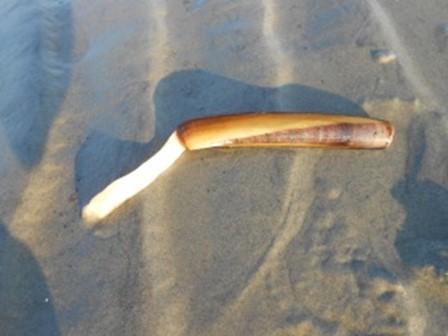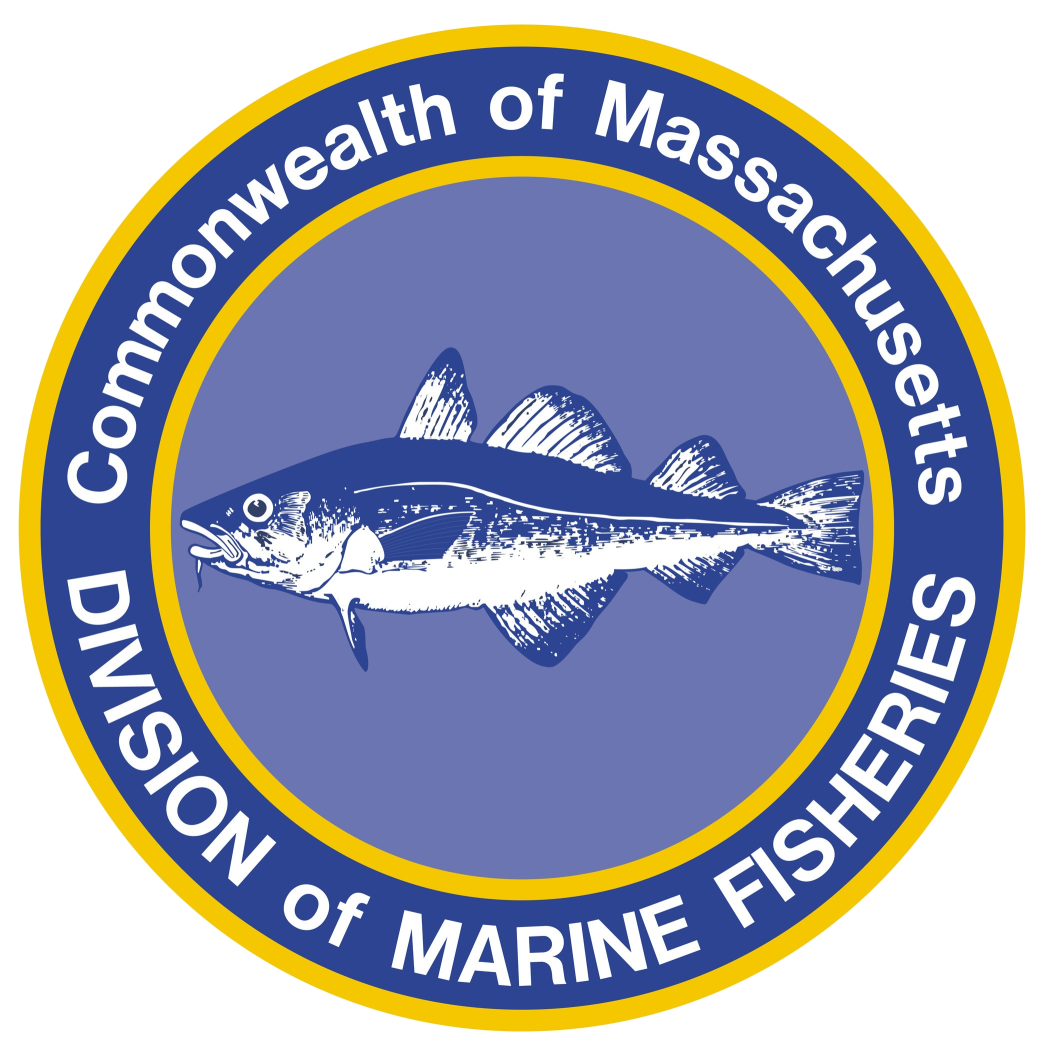- Division of Marine Fisheries

Description: Razor clams are long thin bivalve shellfish that resemble old fashioned straight-edge razors for shaving. Like steamers, they are soft-shelled and rather delicate, but as their common name would imply the edges of their shells can be sharp and may slice your hands and feet. There are many species of clams given this common name but in Massachusetts we are typically referring to the species Ensis leei, formerly Ensis directus. Other names include the common razor clam, bamboo clam, Atlantic razor clam, or jackknife clam. The razor clam is easily identified by its long thin shell that is nearly six times as long as it is wide and has a slight curve to it. They range in color from black and brown to gray and white, matching the sandy or muddy substrate they are found in. There is a gap in the top of the razor clam’s shell where the siphon protrudes surrounded by short sensory tentacles, and another gap at the bottom for their muscular foot. This large foot can extend to near half of the body length of the clam allowing the clam to dig quickly, swim, and even jump.
Scallops are well-known for their mobility, but razor clams are also a highly mobile bivalve species due to their shape and size of this muscular foot. They are specifically known for burrowing very deep, very quickly. Most other bivalve species are consigned to the same patch of mud they settled in as larvae, only being able to move vertically within the substrate—but not quickly. The long thin shape of the shell, muscular foot and unique burrowing strategy of the razor clam allow it to quickly tunnel deep into the sediment. Once the clam pushes its foot into the sand, it constricts valves inside its shell causing a sudden vacuum to exist in the sand around its foot. That vacuum is then filled almost instantly with water rushing in from the surrounding sand, fluidizing the sand around it and creating a localized quicksand effect. Then by extending the foot and retracting it quickly a stream of water flows through the mantle, forcing the substrate out of the way and allowing the razor clam to burrow up to three feet in under two minutes. This same motion allows them to swim through the water with a form of jet propulsion similar to squid or octopus. Another method of travel is by “jumping”; the clam will curl its foot under the shell and then rapidly retract it causing the clam to push off the flat. Razor clams will jump to escape from predators, or if the environmental conditions they reside in are no longer acceptable. Unlike most other bivalves, razor clams just up and leave when their current conditions are intolerable.
Distribution and Habitat: Common razor clams can be found on the Western side of the Atlantic Ocean from Canada to South Carolina in intertidal and subtidal areas up to 120 feet deep. They have been introduced to Europe and are known there by the scientific name Ensis americanus. In Massachusetts, razor clams are harvested both commercially and recreationally. While they can be found in both intertidal and subtidal areas, they tend to preferentially inhabit the lower intertidal zone which limits harvest to larger tides. This challenge, along with relatively high harvest effort due to their delicate shells and quick digging ability has caused them to be a less popular target than other bivalve shellfish species.
Reproduction and Life History: Razor clams are dioecious, meaning gametes are produced by separate sexes. Razor clams produce between one-half million to two million eggs. Spawning is based on temperature but most often occurs in late spring to early summer. Like most other bivalve shellfish, temperature triggers a large, synchronized spawning event. Known as broadcast spawning, male and female gametes are released simultaneously and fertilization occurs externally. Clam development occurs following the same process as other bivalve shellfish, going from fertilized eggs to trochophore larvae that are part of the plankton, drifting along at the mercy of the tide and currents. Free swimming veliger larvae are the next stage in development, and then tiny juveniles (seed/spat) resembling an adult razor clam settle to the bottom to begin their lives in the sand or mud flats. From gametes to free swimming larvae and finally miniscule clams the process takes a little over two weeks. Razor clams can tolerate a large range of salinities, from open ocean to brackish estuaries down to 15 parts per thousand. Juvenile clams settle once a suitable location is found but are highly mobile and will continue to migrate if conditions change. Razor clams reach marketable size between two to five years dependent on geographical location and local harvest restrictions. Razor clams are subject to a multitude of predators from both above and below. During low tide, sea birds and humans will pluck them from their holes. When submerged, they are vulnerable to crabs and fish species such as black sea bass and tautog that will nip at their exposed siphons, and milky ribbon worms will attack from below. Razor clams are also subject to high natural mortality during extremely cold winters. If they manage to avoid predation and harsh winters, razor clams can reach a maximum size of nearly 8 inches and live up to eight years.
Fisheries Management: While razor clams are a highly mobile shellfish species, they inhabit nearshore coastal areas and are at risk of being contaminated by sewage and other pollutants. Razor clams, like other bivalves, are filter feeders and can accumulate high levels of pollutants from their watery environment. The sanitary quality of the waters above shellfish beds needs to be monitored and evaluated to protect public health.
The Division of Marine Fisheries (DMF) Shellfish Sanitation and Management Program is responsible for monitoring and classifying the sanitary quality of the waters of the Commonwealth. Shellfish growing area classifications are assigned based on the results of sanitary surveys that assess actual and potential pollution sources in the area. The classification determines whether shellfish in the area can be harvested for human consumption. In Massachusetts, there are five Shellfish Growing Area Classifications. Razor clams may be harvested in Approved or Conditionally Approved growing areas in the Open status. Commercial razor clam harvest in Massachusetts was valued at almost $1.7 million with over 291,000 pounds landed in 2021.
On the east coast of the U.S., most states have sole authority to manage shellfish. In contrast, Massachusetts shares management and control with municipalities. Under this “home rule” management system, coastal municipalities—subject to MA statute and regulations—exert management control over all bivalve shellfish (except surf clams and ocean quahogs) in waters that are not considered contaminated. DMF has not established a minimum legal size for razor clams, but some municipalities have. It is best to consult with local authorities for regulations and permit requirements. Methods of harvest vary by town; standard clam forks are commonly used to obtain razor clams in north shore municipalities, but some towns on Cape Cod and the Islands also allow use of hand plungers, or application of a food grade salt solution to the burrow which causes the clams to quickly rise and pop out of its hole. It is unlawful to use other substances, such as bleach, to irritate clams out of their burrow.
While the razor clam fishery in Massachusetts is exclusively wild harvest, the aquaculture industry has shown increasing interest in culturing razor clams. A major obstacle to the growth of razor clam culture is a lack of hatchery success with early post-set nursery culture. Efforts are underway to develop technologies that maximize the production and survival of razor clam seed for out-planting on shellfish license sites.
More information on the status of the razor clam industry in MA can be found in the Massachusetts Shellfish Initiative (MSI) 2020 Assessment Report.
By Melissa Campbell and Christian Petitpas, Shellfish Sanitation and Management Program
